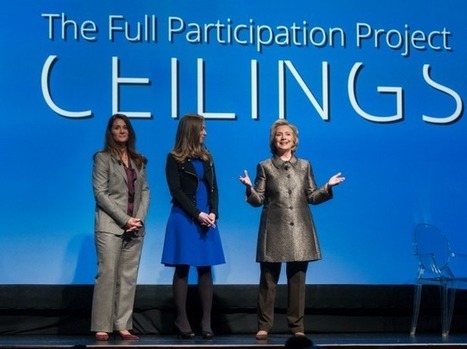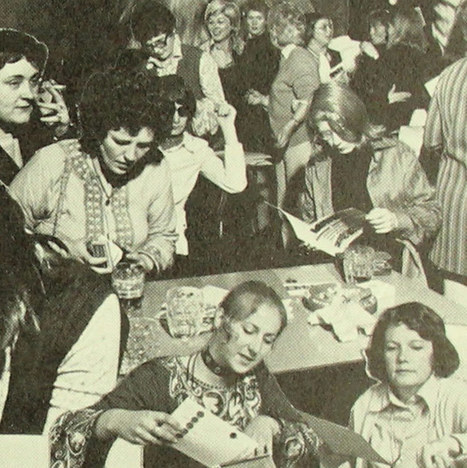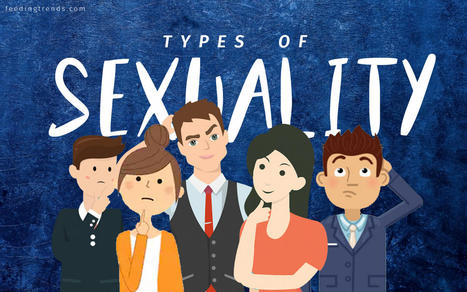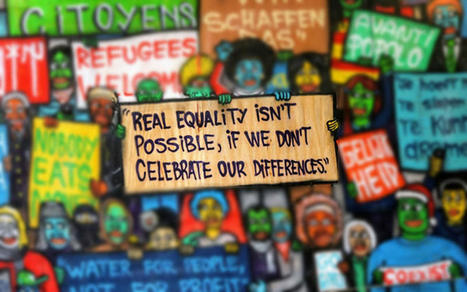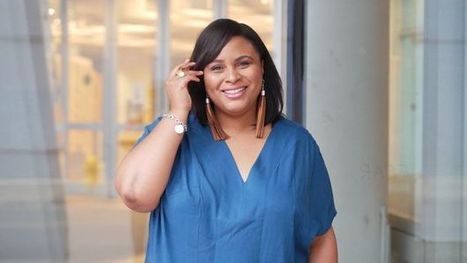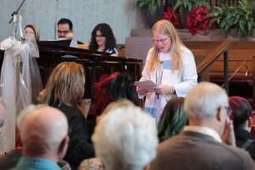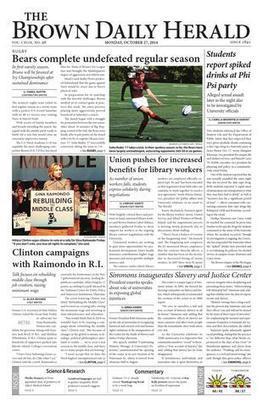 Your new post is loading...
 Your new post is loading...
On International Women’s Day this past Monday, I attended the release of the Clinton Foundation’s No Ceilings: The Full Participation Report, which Hillary Clinton launched alongside Melinda Gates and Chelsea Clinton. Building off the momentum generated at the UN Fourth World Conference on Women in Beijing in 1995, the No Ceilings report uses data collected over the last twenty years to note both the gains and gaps in women and girls’ participation globally.
This September marks the twentieth anniversary of the Beijing Conference, a landmark moment where world leaders, in effect, embraced then-First Lady Hillary Clinton’s statement at the Conference that “women’s rights are human rights.” Clinton and her family’s foundation have continued to push for women’s rights and empowerment. Full disclosure: having attended the Beijing Conference and been moved by Clinton’s speech there, I later had an opportunity to work on the Secretary of State’s Policy Planning Staff under her leadership and Policy Planning’s first woman director, Anne-Marie Slaughter.
The No Ceilings report highlights the progress women and girls have made, for example, in increased access to primary education, an overall drop in maternal mortality, and the growing recognition of the importance of women to peace and security. At the same time, it underscores the gaps that persist for women and girls, including the life expectancy of women in poor and marginalized areas, low rate of attainment in secondary education, the continuing epidemic of violence against women, overall stagnation in women’s workforce participation, and women’s exclusion from peace and security processes.
The report’s emphasis on data—and, indeed, Secretary Clinton’s focus on gender data as a way to address these issues—measures the progress of women and girls internationally and invites policymakers, academics, and activists to take stock of the women’s rights movement. Where is the movement now, and where should it head next?
Since the Beijing Conference, there has been a major push for the inclusion of women in international matters, including peace and security discussions, and this drive has elicited a promising response. Though there is still work to be done—as Ambassador Melanne Verveer noted at Monday’s event, only 4 percent of peacekeeping forces are female—policy developments such as UN Security Council Resolution 1325 on Women, Peace, and Security (and various countries’ national action plans implementing Resolution 1325) show the broad acceptance of the idea that women and women’s rights are critical to the peace and security dialogue. Yet the question remains: has the security paradigm actually changed, or are women simply inserting themselves in a male-dominated regime and culture? To what extent are women transforming the paradigm to pave the way for stemming conflicts, countering violent extremism, and establishing more sustainable peace?
And if a major goal of the women’s rights movement, at least since the Beijing Conference, has been to open up opportunities for women’s leadership—not only in peace and security matters, but in other sectors as well—what is the movement’s main objective now? Much has been said about breaking a final glass ceiling: electing a woman president. As Liberian President Ellen Johnson Sirleaf said at the No Ceilings event, “That glass ceiling is broken—by me.” However, what about the sticky floors and broken ladders to opportunity that women and girls around the globe still face? Will placing more women into positions of power help them?
Via Dr Lendy Spires
One of our 'women in tech' April Forsyth explains how she found her way to the domain name industry - and why it's ok to love fashion and tech
Via Beeyond
One of the first acts of our new House of Representatives might be to cancel Mom. On Sunday, Speaker Nancy Pelosi’s Democratic majority proposed to eliminate “father, mother, son, daughter, brother…
Via Rob Duke
Description by The Scout Report "UK readers are likely aware of the award-winning Glasgow Women's Library, and readers around the world may delight in this opportunity to become acquainted. The library champions women's achievements and contributions, and also seeks to dismantle gender inequalities that continue to persist. The library's LGBTQ Collections Online Resource draws on this mission by highlighting some key resources from the physical Lesbian Archive in an accessible, online format. This online resource is composed of several collections: Early Lesbian and Gay Publications, Feminism and Lesbian Politics, We Recuit!: Campaigns and Organisations, The Personal is Political: Lesbian Life, and LGBTQ Life in Scotland. These collections feature various media, including art and clothing, but a bulk of the materials are publications, pamphlets, and other snippets of literary work. For additional information readers may want to explore the Bibliography page, which lists other materials used in developing the LGBTQ Collections Online Resource. Additionally, readers on Twitter can stay up-to-date with new additions to the Lesbian Archive by following the hashtag #gwllesbianarchive."
Via Jim Lerman
It’s not really a matter of slow vs. fast, and there are things you can do to nudge into lower or higher gear.
Via Peter Mellow

|
Suggested by
Aditya K
|
This article lists the various types of sexuality or the categories in which sexualism is divided along with their definitions. This Feeding Trends article let you know of your sexual category. Read along with the article and get your sex definitions right.
Comparing Gender and Media Equality across the Globe, GEM
https://www.gu.se/en/research/comparing-gender-and-media-equality a research project led by the University of Gothenberg which has culminated in an open acess book Comparing Gender and Media Across the Globe: A cross-national study of the qualities, causes and consequences of gender equality in and through the news media it covers the nature, causes and consequences of gender inequality it also provides free access to several major datasets: (Global Media Monitoring Project, GMMP, The Global Report on the Status of Women in the News Media, IWMF, and Women in Media in Europe, The European Institute for Gender Equality, EIGE) as well as a selection of other key context variables – measures of gender equality in society, women’s political representation, and economic development. The data set also includes the GEM-index, which is a composite index measuring the level of gender equality in news media content in different countries
Via heather dawson
Sait Demir, İlker Türker Biomedical Signal Processing and Control
Volume 64, February 2021, 102222 • Functional brain networks employing coherence method is conducted in a comparative manner across EEG bands. • Female brain is more connected under rest condition, while male brain boosts connectivity under arithmetic workload. • Unsuccessful brains yield more assortative behavior based on beta band networks. • Arithmetically successful brains yield greater connectivity under rest condition for most EEG bands. • Theta band better diagnoses gender-based differences, while gamma band better discriminates success-based connectivity. Read the full article at: www.sciencedirect.com
Via Complexity Digest
About 50,000 cases of abuse or harassment take place every year, report finds
Via Peter Mellow
Unequal inheritance rights will not just keep women poor, but also increase their dependence on men leading to unequal economic and social outcomes for both households and economy...
I met the face of an unconditionally loving God in the gaze of my own mother, to whom I came out to as a young priest.
Via Matt Skallerud
If AI is a simulation of human intelligence, who does it simulate and does it have a gender? Read on to know does the artificial intelligence have
Via Charles Tiayon
|
OneZero’s General Intelligence is a roundup of the most important artificial intelligence and facial recognition news of the week. Bias in artificial intelligence is notoriously problematic. Facial…
The hospital at which I’ll be giving birth in a few months’ time currently allows partners to accompany pregnant women to three events: the first scan, the second scan and the birth itself. To lower the risk of coronavirus transmission, partners are also required to wait outside the maternity unit before the appointment. Arriving at my first scan, husband in tow, the receptionist took one look at the pair of us and, despite the fact I wasn’t yet showing, knew exactly who to boot out into the cold. “You, out!” she said, pointing at the male, who meekly sloped off to wait in the car park. I thought of that moment recently, when the Brighton and Sussex University Hospitals NHS Trust became the first in the UK to officially adopt gender-inclusive language in its perinatal services. This means avoiding feminine pronouns where applicable, referring to the “birthing person” (formerly known as “mother”), and removing the word “breast”, recommending instead the terms “chest-feeding” and “human milk”. This change will be applied to the language used in official NHS literature. Yet, even in uber-progressive Brighton, I think it highly unlikely that a significant number of health professionals will actually start using the term “chest-feeding” (along with “breastfeeding”) when speaking to patients, given its clunkiness, and given that, at least in my experience, people who work in maternity services can often be rather candid about biological reality. No one bothered to ask my husband if he might be the “birthing person” when he showed up at our maternity unit, and rightly so. After all, the number of people who will benefit from this move is truly tiny: specifically, we are concerned here with trans or non-binary people, who are biologically female, and able to bear a child following any surgical or hormonal interventions undergone as part of sex reassignment, and decide to do so, and care about squabbles over vocabulary. The NHS does not currently keep a record of how many trans people give birth every year in the UK, but in Australia the figure is in the dozens. Unfortunately, there is another group – and a much larger one – who might be alienated by efforts to make medical vocabulary more trans-inclusive and therefore also (if inadvertently) more obscure. The 2011 census records that 1.3 per cent of the population of England and Wales cannot speak English well, and 0.3 per cent cannot speak English at all, and the majority of these people are women. The problem is particularly acute among British Muslims, with almost a quarter of Muslim women reporting that they either do not speak English or do not speak it well. My hospital happens to cover an area with a large Muslim population, and it’s not uncommon to see women in the maternity unit struggling to make themselves understood by staff. The problem has been made worse during the pandemic, as friends and relatives have been banned from waiting rooms and so cannot act as translators. There are phone translation services available, but – as I witnessed from the other side, when I was (briefly) a medical student – they’re not always straightforward to use. And even if some leaflets might be translated into other languages, the posters and signs on the wall are all in English. [see also: Why should CNN tweet about “individuals with a cervix”?] I was told by one midwife that the first maternity appointment – which includes crucial assessments of health, genetic background and risk of domestic violence – typically takes twice as long for those patients who struggle with English. Now try adding terms such as “chest-feeding” and “birthing person” to the official forms. Or, rather than ask that “women” present themselves for a smear test, NHS letters and poster campaigns might use gender-neutral language and direct the appeal instead to “individuals with a cervix”, the phrase used by the American Cancer Society. This kind of language is feted as “more inclusive”, but the question we should be asking is, inclusive of whom? Attendance at cervical screenings is at a ten-year low, and late diagnosis hugely increases mortality risk. But, unfortunately, less than 50 per cent of UK women know where the cervix is, and those who do are disproportionately likely to have more educational qualifications and be native English speakers. The costs of confusing public health messaging are suffered more by some groups than by others, but this can all too easily be forgotten by progressive elites in the rush to signal inclusiveness. The psychologist Rob Henderson has coined the term “luxury beliefs” to describe, as he puts it, “ideas and opinions that confer status on the rich at very little cost, while taking a toll on the lower class”. For instance, a member of the bourgeoisie can elevate his status by proposing to “defund the police” with little fear of negative consequences for himself if this policy were ever enacted, since those most affected by crime are poor people who can’t afford to move away from dangerous areas. Similarly, rich people in the modern West can experiment with alternative relationship arrangements, such as having multiple partners, in the knowledge they can always fall back on their financial and social capital if it doesn’t work out. But not everyone has the luxury of rewriting relationship norms. A poor woman with several children by several different men, for example, is placed in an intolerably precarious situation if she finds herself suddenly single. For the rich, luxury beliefs are about gain with little pain. The elaborate dance involved in avoiding using words such as “mother” and “breast” offers those at the cutting edge of political discourse the opportunity to demonstrate their status at no cost to themselves. That does not, however, mean there is no cost to be borne by anyone else. [see also: Judith Butler on the culture wars, JK Rowling and living in “anti-intellectual times”]
Via Charles Tiayon
A national survey indicates nearly half of all Year 10-12s have had sex, but experts say sex ed in Australia is a "mixed bag". Is our curriculum too focused on "bugs and babies and bodies"?
Via Peter Mellow
From fighting the pandemic to reengineering American politics, the influential women on The World's 100 Most Powerful Women list—including New Zealand Prime Minister Jacinda Ardern, vice-president elect Kamala Harris and voting rights advocate Stacey Abrams—are making history.
Via Anat Lechner
Are you a Feminist? If Yes.. then answer my 5 questions about privileges you get being a Woman over a Man. Read why movies like “ki and kaa” only exist on screen and not in real life. Find out why we are missing “International Boy Child Day” and why exactly we should not miss it. Does Sexism exist in Men too? Feeding Trends finds out in this article.
Women in India have seen discrimination on basis of sex in the name of religion too. There are 9 holy places in India where women entry was or is prohibited. Feeding Trends article written by Sana Ummeed throws light on the name of places where women are not allowed or women entry is banned or women entry is prohibited. Lord Ayyapa Temple, Haji Ali Dargah, Lord Karthikey Temple, Shreeanabhaswamy Temple, Jain temple, Nizamuddin Aulia Dargah, Jama Masjid Delhi, Idgah Masjid Shillong, have been involved in this.
Via Aditya K
A New web Archive from the Ivy Plus Libraries Confederation it currently includes 74 web archived resources covering lgbt plus activism in South Asia and its diaspora. these are valuable for grass roots discussion of gay and transgender rights , pride and cultural events and responses to government policy which may not be reported elsewhere
Via heather dawson
Women perform a large number of essential and unique roles in society. That fact is undeniable. From authors and actresses to CEOs and engineers: Women prove time and time again that they can perfo…
Via ICTmagic, Jim Lerman
An increasing number of brands are extending size ranges. It’s an improvement for plus-size consumers – but are companies’ motivations always in the right place?
Via Peter Mellow
The ceremony included one marriage and 19 vow renewals. It came as the United Methodist Church implemented stricter LGBTQ rules.
Via Matt Skallerud
Here are the sex differences in the brain that are backed by science. A prevalent understanding, particularly in the 1980s, was that boys and girls are born cognitively the same. It was the way parents and society treated them that made them different. Since then, a preponderance of research has called this belief into question. The majority of today's psychologists agree that some of the differences exhibited by male and female brains are innate. "We do socialize our boys and girls differently, but the contribution of biology is not zero," said Diane Halpern, a professor of psychology at Claremont McKenna College in California, who has been studying cognitive gender differences for 25 years. Halpern was a keynote speaker at the British Psychological Society Annual Conference here last Thursday (April 19).
Via Charles Tiayon
Countries where citizens speak gendered languages — in which nouns are masculine or feminine — display a higher rate of gender inequality than countries with languages that do not ascribe gender to nouns, said Jennifer Prewitt-Freilino, the only full-time psychology professor at the Rhode Island School of Design.
She presented her research about the relationship between language and gender inequality at a lecture hosted by Brown’s Department of Cognitive, Linguistic and Psychological Sciences Friday in Metcalf 305.
Though women are now overtaking men in areas like college enrollment, many inequalities still exist between men and women, Prewitt-Freilino said.
“In no country is there even equal pay,” she said. “Women are paid about 16 percent less than men.”
But the amount of inequality “is not uniform across cultures,” she added, citing language as a possible contributing factor in such differences in equality.
Language is “usually seen as not that important, but research over the last decade has suggested that how we speak also influences how we think,” she said.
Prewitt-Freilino hypothesized that “countries that speak predominantly gendered language should evidence less gender equality relative to countries with natural gender and genderless language countries.” Gendered languages are those with masculine and feminine words, such as Spanish. Natural gender languages are those in which most nouns are not gendered, but pronouns like “he” or “she” are gendered, such as in English. Genderless languages are those in which both nouns and pronouns are not gendered.
Prewitt-Freilino took data from 134 countries, of which 111 had primary languages that fit into one of the three categories. She identified 26 genderless, 12 natural gender and 73 gendered language countries and then looked at the Global Gender Gap index, a measurement of national gender gap, for each of the countries. The GGG index “benchmarks national gender gaps of 136 countries on economic, political, education- and health-based criteria,” according to its website. Each country is given a score between zero — denoting absolute inequality — and one, for absolute equality.
Prewitt-Freilino found that the average scores for countries with genderless, natural gender and gendered languages were 0.68, 0.74 and 0.67, respectively.
The data supported her hypothesis that gendered languages have the most inequality, she said.
Since countries with similar languages often have other common links, Prewitt-Freilino looked at human development, religious tradition, geographic location and system of government as covariates that might affect the data. She then examined the data after accounting for these covariates, and found the average scores for countries with genderless, natural gender and gendered languages to be 0.70, 0.72 and 0.67, respectively: Gendered language countries still had the highest average inequality.
Prewitt-Freilino said previous studies found the same phenomenon that she noted.
In one study she cited, German-speaking and Spanish-speaking participants were asked to describe qualities of a key, a word that is masculine in German and feminine in Spanish. The German speakers often used words like “hard, heavy, jagged and metal” to describe the key, whereas Spanish speakers often used words like “golden, intricate, little and shiny” to describe the key.
In another study she cited, children were asked to write a story in response to a prompt with one of the three pronouns: “When a kid goes to school, (he/they/he or she) often feels excited on the first day.” The researchers found that only 12 percent and 18 percent wrote about female characters when given “he” or “they,” respectively. But 42 percent wrote about female characters when “he or she” was used in the prompt. Prewitt-Freilino suggested that this may be because people do not think about writing a female character unless “she” is explicitly mentioned.
Though she has identified an initial correlation, Prewitt-Freilino continues her work on gender differences in language use and perception, studying how the way men and women describe success and failure affects what others think of them.
She hypothesized that “women would view a candidate more positively when they shared success (by using “we”) and took personal responsibility for a failure (by using “I”) whereas men would view a candidate more positively when they took credit for success and (deflected) blame for loss.”
Prewitt-Freilino then conducted a new study, in which participants were asked to read a quotation from a student government candidate. The quote described a fundraising goal, where the candidate either failed or succeeded and used either “I” or “we” when discussing the fundraiser. She found that women liked “we” more if the candidate succeeded, whereas men valued personal success more and tended to not support the candidates who said, “I failed.”
She concluded the lecture by describing how subtle language differences can shape thought processes, which can affect social interaction.
“Not only is language a source for conveying current systems of hierarchy, but (it) might also be a way of reproducing them,” she said.
Xuan Zhao GS, who attended the lecture, said she enjoyed the lecture, as it was interesting to think about how language influences gender equity.
She expressed surprise to learn that some school kids have a male-dominant bias, as evidenced by one of the studies mentioned.
Via Charles Tiayon
|



 Your new post is loading...
Your new post is loading...

